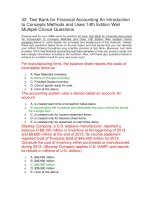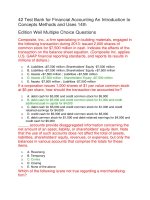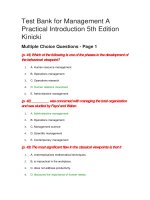Test bank for 2012 microbiology an introduction, 11th edition
Bạn đang xem bản rút gọn của tài liệu. Xem và tải ngay bản đầy đủ của tài liệu tại đây (777.52 KB, 15 trang )
full file at
Exam
Name___________________________________
MULTIPLE CHOICE. Choose the one alternative that best completes the statement or answers the question.
1) Which of the following is NOT associated with viruses?
A) capsid
B) envelope
C) spikes
D) organelles
E) nucleic acid
Answer: D
Explanation:
A)
B)
C)
D)
E)
2) Microorganisms are involved in each of the following processes EXCEPT
A) decomposition of organic material.
B) infection.
C) food production.
D) smog production.
E) O2 production.
Answer: D
Explanation:
2)
A)
B)
C)
D)
E)
3) Gene therapy is currently used to treat all of the following diseases EXCEPT
A) cystic fibrosis.
B) severe combined immunodeficiency disease (SCID).
C) colon cancer.
D) Duchenne’s muscular dystrophy.
E) LDL-receptor deficiency.
Answer: C
Explanation:
1)
A)
B)
C)
D)
E)
1
3)
full file at
Figure 1.1
4) The bacterial shape of the cells in Figure 1.1 would best be described as
A) coccus.
B) bacillus.
C) ovoid.
D) columnar.
Answer: B
Explanation:
A)
B)
C)
D)
E)
5) The infectious agent that causes AIDS is a
A) bacterium.
B) mold.
C) virus.
D) protozoan.
E) yeast.
Answer: C
Explanation:
5)
A)
B)
C)
D)
E)
6) In which of the following situations would Koch’s postulates be utilized?
A) determination of the cause of cancer in a patient
B) formulation of a vaccine against a new pathogen in a genetic engineering lab
C) whenever the scientific method is used to investigate a microbiological problem
D) determination of the cause of a patient’s illness in a hospital microbiology lab
E) development of a new antibiotic in a pharmaceutical lab
Answer: D
Explanation:
E) spiral.
4)
A)
B)
C)
D)
E)
2
6)
full file at
7) The major food producers for other living organisms is/are
A) higher plants.
B) cyanobacteria.
C) algae.
D) higher plants and algae.
E) higher plants, cyanobacteria, and algae.
Answer: E
Explanation:
A)
B)
C)
D)
E)
8) Recombinant DNA refers to the
A) interaction between human and bacterial cells.
B) DNA resulting when bacterial genes are inserted in an animal genome.
C) study of bacterial ribosomes.
D) synthesis of proteins from genes.
E) study of the function of genes.
Answer: B
Explanation:
9)
A)
B)
C)
D)
E)
10) The use of phenol (carbolic acid) as a wound disinfectant was first practiced by
A) Lister.
B) Semmelweis.
C) Koch.
D) Holmes.
E) Pasteur.
Answer: A
Explanation:
8)
A)
B)
C)
D)
E)
9) Viruses are not considered living organisms because they
A) are structurally very simple.
B) typically associated with disease.
C) cannot reproduce by themselves.
D) can only be visualized using an electron microscope.
E) are ubiquitous in nature.
Answer: C
Explanation:
7)
A)
B)
C)
D)
E)
3
10)
full file at
11) The formal system for classifying and naming organisms was developed by
A) Carolus Linnaeus.
B) Robert Koch.
C) Aristotle.
D) Louis Pasteur.
E) Ignaz Semmelweis.
Answer: A
Explanation:
A)
B)
C)
D)
E)
12) Microorganisms are essential to our life. Each of the following is an example of a beneficial function
of microorganisms EXCEPT
A) agriculture.
B) increased morbidity.
C) bioremediation.
D) alternative fuel production.
E) gene therapy.
Answer: B
Explanation:
13)
A)
B)
C)
D)
E)
14) The first antibiotic to be utilized was
A) salvarsan.
B) quinine.
C) sulfonamides.
D) penicillin.
E) vancomycin.
Answer: D
Explanation:
12)
A)
B)
C)
D)
E)
13) Antibiotics are produced by
A) bacteria.
B) viruses.
C) fungi.
D) protozoa.
E) bacteria and fungi.
Answer: E
Explanation:
11)
14)
A)
B)
C)
D)
E)
4
full file at
15) Molecular biology is the study of
A) RNA replication.
B) DNA synthesis.
C) enzyme function.
D) the structure and function of macromolecules essential to life.
E) protein synthesis.
Answer: D
Explanation:
A)
B)
C)
D)
E)
16) Protozoan motility structures include
A) cilia.
B) pseudopods.
C) flagella.
D) cilia and pseudopods only.
E) cilia, flagella, and pseudopods.
Answer: E
Explanation:
16)
A)
B)
C)
D)
E)
17) Biogenesis refers to the
A) spontaneous generation of organisms from nonliving matter.
B) development of life forms from preexisting life forms.
C) germ theory of disease.
D) development of aseptic technique.
Answer: B
Explanation:
17)
A)
B)
C)
D)
18) Fungal infections are studied by
A) virologists.
B) parasitologists.
C) mycologists.
D) herpetologists.
E) bacteriologists.
Answer: C
Explanation:
15)
18)
A)
B)
C)
D)
E)
5
full file at
19) Which of the following is NOT a domain in the three-domain system?
A) bacteria
B) archaea
C) eukarya
Answer: D
Explanation:
D) animalia
A)
B)
C)
D)
20) Mycology is the study of
A) protozoa.
B) mycoplasma.
C) mushrooms.
D) molds.
E) molds, yeast, and mushrooms.
Answer: E
Explanation:
20)
A)
B)
C)
D)
E)
21) Which of the following statements about biofilms is FALSE?
A) Biofilms in your body protect mucous membranes from harmful microbes.
B) Biofilms on rocks provide food for animal life.
C) Biofilms in pipes can block the flow of water.
D) Compared to free-living bacteria, biofilms are more sensitive to antibiotics.
E) Biofilms on medical devices cause infections.
Answer: D
Explanation:
21)
A)
B)
C)
D)
E)
22) Common commercial benefits of microorganisms include synthesis of
A) insulin.
B) aspirin.
C) antibiotics.
D) antibiotics and aspirin.
E) antibiotics and insulin.
Answer: E
Explanation:
19)
A)
B)
C)
D)
E)
6
22)
full file at
23) The term used to describe a disease-causing microorganism is
A) microbe.
B) infection.
C) virus.
Answer: E
Explanation:
D) bacterium.
E) pathogen.
A)
B)
C)
D)
E)
24) Archaea differ from bacteria in that archaea
A) lack nuclei.
B) use organic compounds for food.
C) have diverse cell wall compositions.
D) are prokaryotic.
E) reproduce by binary fission.
Answer: C
Explanation:
24)
A)
B)
C)
D)
E)
25) Which of the following findings was essential for Edward Jenner’s vaccination process?
A) A weakened microorganism will not cause disease.
B) Pathogenic microorganisms infect all humans and animals in the same manner.
C) Someone who recovers from a disease will not acquire that disease again.
D) Exposure to a milder disease form may produce immunity.
E) Disease is caused by viruses.
Answer: D
Explanation:
25)
A)
B)
C)
D)
E)
26) Development of emerging infectious disease can be a result of all of the following EXCEPT
A) changes in the environment.
B) overuse of antibiotics.
C) microbial mutation.
D) modern transportation.
E) use of genetically modified foods.
Answer: E
Explanation:
23)
A)
B)
C)
D)
E)
7
26)
full file at
27) Proof that a microbe could cause disease was provided by
A) Pasteur.
B) Lister.
C) Wasserman.
D) Semmelweis.
E) Koch.
Answer: E
Explanation:
A)
B)
C)
D)
E)
28) Who was the first scientist to pursue a “magic bullet” that could be used to treat infectious disease?
A) Ehrlich
B) Semmelweis
C) Pasteur
D) Lister
E) Jenner
Answer: A
Explanation:
29)
A)
B)
C)
D)
E)
30) Classification of organisms into three domains is based on
A) cellular proteins.
B) cellular organization.
C) the presence of a cell wall.
D) nutritional requirements.
E) the number of cells in the organism.
Answer: B
Explanation:
28)
A)
B)
C)
D)
E)
29) If you were setting up an experiment to disprove spontaneous generation in a liquid medium,
which of the following would be essential to the experiment?
A) using a sterile liquid and eliminating exposure to microorganisms
B) adding carbon dioxide to the liquid
C) starting with a liquid that contains microorganisms
D) adding antibiotics to the liquid
E) supplying the liquid with nutrients
Answer: A
Explanation:
27)
A)
B)
C)
D)
E)
8
30)
full file at
31) Commercial utilization of microbial products has become increasingly popular due to their
environmentally friendly nature. Removal of these products from the environment typically
utilizes
A) alcohol.
B) organic solvents.
C) soap.
D) enzymes.
E) organic acids.
Answer: D
Explanation:
A)
B)
C)
D)
E)
32) The microbial process of converting sugars to alcohol is known as
A) pasteurization.
B) fermentation.
C) alcoholism.
D) tyndallization.
E) lyophilization.
Answer: B
Explanation:
32)
A)
B)
C)
D)
E)
33) ________ is the physician first associated with vaccination.
A) Jenner
B) Pasteur
C) Lister
Answer: A
Explanation:
D) Koch
E) Escherich
33)
A)
B)
C)
D)
E)
34) Normal microbiota are typically found in and on all the following body locations EXCEPT the
A) skin.
B) blood.
C) colon.
D) mouth.
E) upper respiratory system.
Answer: B
Explanation:
31)
A)
B)
C)
D)
E)
9
34)
full file at
35) Recombinant DNA technology has become an increasingly important part of our life. It is used for
all of the following EXCEPT
A) drug production.
B) enhancing food longevity.
C) synthesis of water.
D) vaccine production.
E) increasing the nutritional value of food.
Answer: C
Explanation:
A)
B)
C)
D)
E)
36) Who is credited with first observing microorganisms?
A) Robert Hooke
B) Anton van Leeuwenhoek
C) Louis Pasteur
D) Robert Koch
E) Carolus Linnaeus
Answer: B
Explanation:
37)
A)
B)
C)
D)
E)
38) Robert Koch identified the cause of
A) diphtheria.
B) tuberculosis.
C) smallpox.
D) anthrax.
E) AIDS.
Answer: D
Explanation:
36)
A)
B)
C)
D)
E)
37) The first step for directly linking a microbe to a specific disease according to Koch’s postulates is to
A) inject a sample of blood or other body fluid from a diseased animal into a healthy animal.
B) isolate microbes from the blood of healthy animals.
C) culture the blood or other body fluid from a diseased animal using nutrient medium.
D) obtain a sample of blood or other body fluid from a diseased animal.
E) compare the blood of a sick animal to blood obtained from a healthy animal.
Answer: D
Explanation:
35)
38)
A)
B)
C)
D)
E)
10
full file at
39) Regarding Louis Pasteur’s experiments with the S-neck flask, which of the following statements is
TRUE?
A) Air exchange was involved.
B) All preexisting microorganisms were killed.
C) A food source was provided.
D) The possibility of contamination was removed.
E) All of the answers are correct.
Answer: E
Explanation:
A)
B)
C)
D)
E)
40) Who is credited with first observing cells?
A) Anton van Leeuwenhoek
B) Louis Pasteur
C) Carolus Linnaeus
D) Robert Koch
E) Robert Hooke
Answer: E
Explanation:
40)
A)
B)
C)
D)
E)
41) In the name Staphylococcus aureus, aureus is the
A) genus.
B) kingdom.
C) domain name.
D) family name.
E) specific name.
Answer: E
Explanation:
41)
A)
B)
C)
D)
E)
42) A prokaryotic cell may possess each of the following cellular components EXCEPT
A) ribosomes.
B) a nucleus.
C) a cell wall.
D) flagella.
E) a cell membrane.
Answer: B
Explanation:
39)
A)
B)
C)
D)
E)
11
42)
full file at
43) Each of the following organisms would be considered a microbe EXCEPT
A) virus.
B) bacterium.
C) mushroom.
D) yeast.
E) protozoan.
Answer: C
Explanation:
A)
B)
C)
D)
E)
44) The arguments supporting spontaneous generation were finally disproved by
A) Louis Pasteur.
B) John Needham.
C) Lazzaro Spallanzani.
D) Francesco Redi.
E) Rudolf Virchow.
Answer: A
Explanation:
44)
A)
B)
C)
D)
E)
45) Vaccinations are available for all of the following diseases EXCEPT
A) mumps.
B) hepatitis B.
C) rubella.
D) measles.
E) strep throat.
Answer: E
Explanation:
43)
45)
A)
B)
C)
D)
E)
TRUE/FALSE. Write 'T' if the statement is true and 'F' if the statement is false.
46) Bovine spongiform encephalitis (BSE, or “mad cow disease”) is caused by a virus.
Answer:
True
Explanation:
False
47) All pathogens known to infect humans have been identified at this point in time.
Answer:
True
Explanation:
46)
False
12
47)
full file at
48) Infectious disease is almost totally eradicated in our world.
Answer:
True
Explanation:
False
49) The process of pasteurization to reduce food spoilage utilizes high heat to kill all bacteria present.
Answer:
True
Explanation:
51)
False
52) All cells possess a cell wall.
Answer:
True
Explanation:
52)
False
53) Microbes are associated with life-sustaining benefits as well as life-threatening diseases.
Answer:
True
Explanation:
54)
False
55) A student has obtained a sample of pond water for study. Using the high-power lens, he observes
several cells with nuclei. He can conclude that the cells are NOT bacteria.
Answer:
True
Explanation:
53)
False
54) Anton van Leeuwenhoek was the first microbiologist to use a microscope to examine
environmental samples for the presence of microorganisms.
Answer:
True
Explanation:
50)
False
51) Some viruses can contain both DNA and RNA.
Answer:
True
Explanation:
49)
False
50) Spontaneous generation refers to living cells arising only from other living cells.
Answer:
True
Explanation:
48)
55)
False
ESSAY. Write your answer in the space provided or on a separate sheet of paper.
56) Explain the germ theory of disease and discuss why this theory is essential to the treatment of infectious disease.
Answer:
57) What was the function and importance of S-necked flasks in Louis Pasteur’s experiments in disproving
spontaneous generation?
Answer:
58) Compare and contrast prokaryotic and eukaryotic cells.
Answer:
59) What is an emerging disease, and what are some of the sources for these “new” infectious diseases?
Answer:
13
full file at
Answer Key
Testname: C1
1)
2)
3)
4)
5)
6)
7)
8)
9)
10)
11)
12)
13)
14)
15)
16)
17)
18)
19)
20)
21)
22)
23)
24)
25)
26)
27)
28)
29)
30)
31)
32)
33)
34)
35)
36)
37)
38)
39)
40)
41)
42)
43)
44)
45)
46)
47)
48)
49)
50)
D
D
C
B
C
D
E
B
C
A
A
B
E
D
D
E
B
C
D
E
D
E
E
C
D
E
E
A
A
B
D
B
A
B
C
B
D
D
E
E
E
B
C
A
E
FALSE
FALSE
FALSE
FALSE
FALSE
14
full file at
Answer Key
Testname: C1
51)
52)
53)
54)
55)
56)
57)
58)
59)
FALSE
FALSE
TRUE
TRUE
TRUE
15









